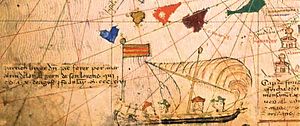Jaume Ferrer facts for kids
Quick facts for kids
Jaume Ferrer
|
|
|---|---|
| Born | |
| Died | after 10 August 1346 |
| Occupation | Ship captain |
| Known for | Expedition to find the legendary "River of Gold" |
Jaume Ferrer (pronounced JOW-muh fuh-RAY) was a brave sailor and explorer from Majorca. This island was once part of the Kingdom of Majorca. In 1346, he set sail from Majorca on a very important mission. He wanted to find a famous place called the "River of Gold." We don't know what happened to him or if he ever found the river. But people in his hometown of Palma, Majorca still remember him today.
Contents
The Quest for the River of Gold

We don't know much about Jaume Ferrer. We do know he was a captain from Majorca. In 1346, he left on a ship called a galley. This was a type of ship that used both sails and oars. He sailed along the coast of West Africa. His goal was to reach the legendary "River of Gold." We don't know if he found it or if he survived his journey.
Some recent studies suggest Jaume Ferrer might have been "Giacomino Ferrar di Casa Maveri." This person was from Genoa, Italy, but his family had moved to Majorca.
The Catalan Atlas Clue
Almost all we know about Ferrer's trip comes from a map called the Catalan Atlas. This map was made in 1375. It was likely created by Abraham Cresques, a mapmaker from Majorca.
In the bottom-left part of the map, there's a colorful ship. It has the flag of the Kingdom of Aragon. A note next to it simply says "Jacme Ferrer" left on an uxer on August 10, 1346. He was looking for the "Riu de l'Or" (River of Gold). An uxer was a cargo ship with one mast and square sails. It also had oars and was often used to carry horses.
The map shows Ferrer's ship below the Canary Islands. This means he probably sailed past Cape Bojador. At that time, this cape was known as the "non plus ultra." This Latin phrase means "nothing further beyond." Sailors believed it was too dangerous to sail past this point.
If Ferrer made it past Cape Bojador and returned, he did it almost 100 years before another famous explorer. That explorer was Gil Eanes, who successfully sailed past the cape in 1434.
A Secret Note
In 1802, a small piece of information was found in old records in Genoa, Italy. It talked about an expedition. It said that "Joannis Ferne," a Catalan sailor, left "the city of the Majorcans" on July 10, 1346. His ship was a galleass, which was a large warship. The note said the ship was never heard from again.
It also mentioned that he was looking for the Riu Auri (River of Gold). He had heard that this river was a place where "gold nuggets" were collected. The people living along the river were said to be collecting gold. The river itself was described as wide and deep enough for big ships.
What Was the River of Gold?
The "River of Gold" was often talked about by traders who crossed the Sahara Desert. It was actually the Senegal River. This river flowed into the heart of the Mali Empire, a place famous for its gold.
The old Genoese note also called the river Vedamel. This name likely came from Arabic words. It might mean 'river of treasure' (Wad al-mal). Or it could be a mistake for 'river of the Nile' (Wad al-Nill). The Senegal River was sometimes called the 'Western Nile'. The name Vedamel might also be the origin of Budomel. This was a name used by early Portuguese explorers in the 1400s. It referred to a Wolof kingdom south of the Senegal River.
Remembering Jaume Ferrer
Even though we don't know much about him, Jaume Ferrer is remembered in his hometown of Palma, Majorca. There is a street named after him. You can also find a statue of him in the Plaça de les Drassanes square. There is even a relief (a type of sculpture) of him in the town hall.
The statue you see today is a copy. The original was made around 1843 by Jacint Mateu. But in 1914, it was replaced by a new version with some changes by Joan Grauches. The first statue is now in the old Consolat de Mar building in Palma. The ship from the Catalan Atlas is also shown on a huge sundial along the city's waterfront.
See also
 In Spanish: Jaume Ferrer (navegante) para niños
In Spanish: Jaume Ferrer (navegante) para niños
- List of people who disappeared mysteriously at sea
- Río de Oro, a former Spanish province in northwest Africa
Sources
- Betz, R.L. (2007) The Mapping of Africa: a cartobibliography of printed maps of the African continent to 1700, Hes & de Graaf


